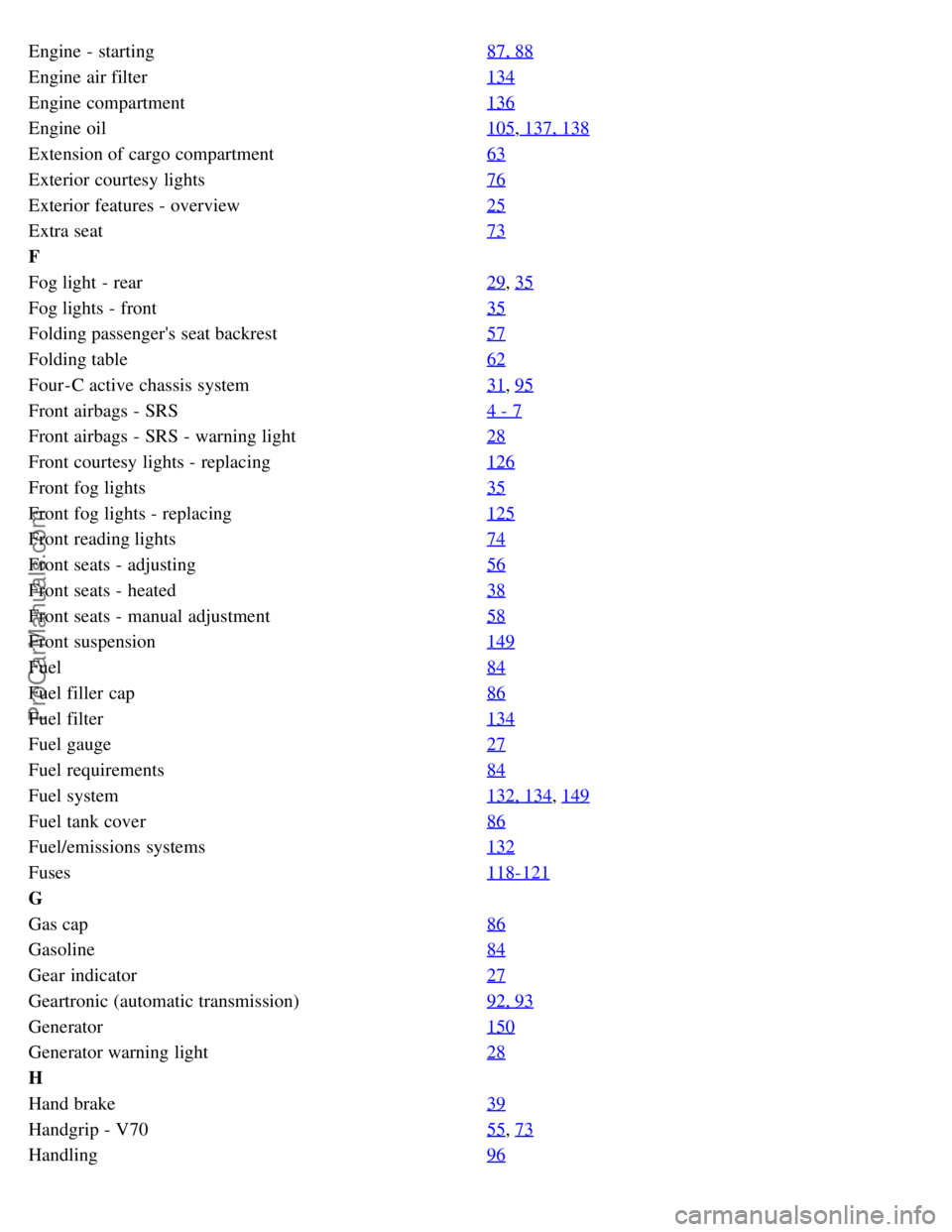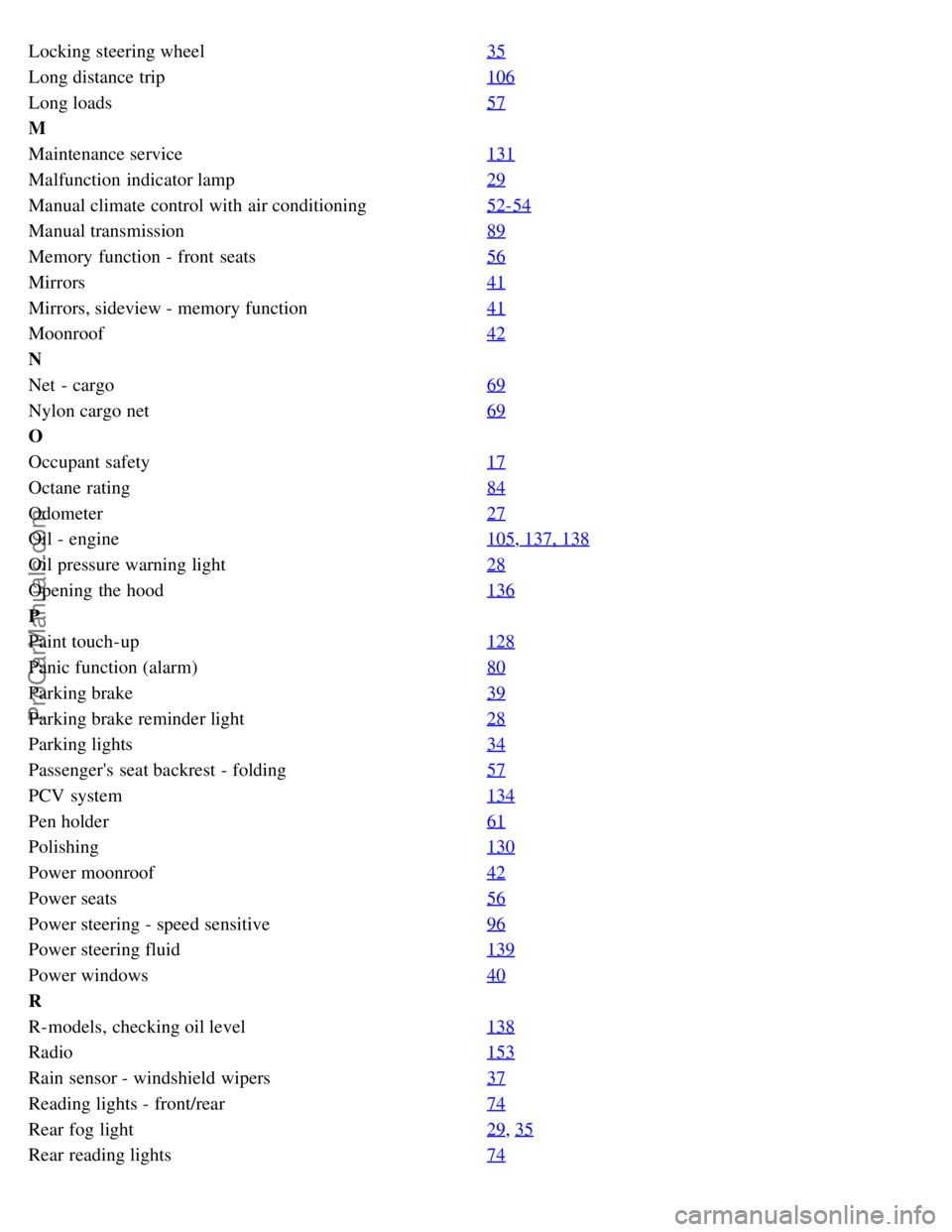engine VOLVO V70 2004 Service Manual
[x] Cancel search | Manufacturer: VOLVO, Model Year: 2004, Model line: V70, Model: VOLVO V70 2004Pages: 127, PDF Size: 3.08 MB
Page 100 of 127

Volume: 7.9 US qts (7.5 liters)
Cooling system
Type: Positive pressure, closed system. The thermostat begins to open at 194 °F (90 °C)
Coolant: Volvo original coolant/antifreeze
Power steering fluid
ATF fluid
Volume: 0.95 US qts (0.9 liters)
Brake fluid
DOT 4+ boiling point >536°F(280°C), P/N 9437433
Volume: 0.64 US qts (0.6 liters)
Climate control system - refrigerant (R 134a)
Oil: PAG
Volume: 2.2 lbs (1,000 g) R134a
Fuel
Minimum octane requirement - AKI 87 (RON 91)
Fuel tank volume:
Front wheel drive models:18.5 US gal. (70 liters)
All Wheel Drive models: 19 US gal. (72 liters)
V70R: 18 US gal. (68 liters)
Washer fluid reservoir
Volume: 4.7 US qts (4.5 liters)
All specifications are subject to change without prior notice.
pg. 149 Fuel system, Distributor ignition system, Suspension
Fuel system
The engine is equipped with a multiport fuel injection system.
Distributor ignition system
Firing order: 1-2-4-5-3
Electronic ignition setting: Not adjustable
Spark plugs: Champion RC8PYP 8 (or equivalent)
ProCarManuals.com
Page 101 of 127

Spark plug gap: 0.028-0.032" (0.7-0.8 mm)
Tightening torque: 18.4 ft. lbs. (25 Nm) WARNING!
The ignition system operates at very high voltages. Special safety precautions must be followed to prevent injury.
Always turn the ignition off when:
Replacing ignition components e.g. plugs, coil, etc.
Do not touch any part of the ignition system while the engine is running. This may result in a shock and bodily
injury.
Front suspension
Spring strut suspension with integrated shock absorbers and control arms linked to the support frame. Power-assisted
rack and pinion steering. Safety type steering column. The alignment specifications apply to an unladen car but include
fuel, coolant and spare wheel.
Rear suspension
Individual rear wheel suspension with longitudinal support arms, double link arms and track rods.
All specifications are subject to change without prior notice.
pg. 150 Electrical system
Electrical system
12 Volt, negative ground.
Voltage-controlled generator. Single-wire system with chassis and engine used as conductors. Grounded on chassis.
Battery
Voltage: 12 Volt, capacity: 600 A/115 min reserve capacity.
The battery contains corrosive and poisonous acids. It is of the utmost importance that old batteries are disposed of
correctly. Your Volvo retailer can assist you in this matter.
Generator
Rated output: max. current: 140 A
Starter motor:
Output: 1.7 kW
Bulbs
Bulb US no. Power Socket
Headlights
- High beam HB3 60W -
- Low beam H7 55W -
Bi -Xenon headlights*
ProCarManuals.com
Page 114 of 127

time to complete the training.
The programmed button on your HomeLink® Universal Transceiver should now operate your garage door opener. The
original hand -held transmitter can also be used, as desired, to operate the garage door.
The remaining two HomeLink® buttons can be programmed in the same way. In the event of any problems in
programming the HomeLink® Universal Transceiver, call toll-free 1-800-355-3515 (Internet: www.HomeLink.com
).
Operating the HomeLink® Universal Transceiver
Once programmed, the HomeLink® Universal Transceiver can be used in place of your hand -held transmitters.
To operate, the key must be turned to the "accessory" position (II) or the engine must be running. Press the
programmed HomeLink® button to activate the garage door, driveway gate, security lighting, home security system,
etc.
Your original hand -held transmitters may, of course, be used at any time.
Erasing programmed buttons
Individual buttons cannot be erased. To erase all three programmed buttons:
1. Turn the ignition key to the "accessory" position (II).
2. Hold down the two outside buttons on the HomeLink® Universal Transceiver for about 20 seconds, until
HomeLink®'s indicator light begins to flash.
3. Release both buttons.
The HomeLink® buttons can be reprogrammed using the procedures described on the previous page.
(HomeLink® information continues on the next page)
pg. 171 HomeLink® Universal Transceiver (option)
Reprogramming a single HomeLink® button
1. Press and hold the desired HomeLink® button. Do not release the button until step 3 has been completed.
2. When the indicator light begins to flash slowly (after approximately 20 seconds), position your hand -held
transmitter 2 to 5 in. (5 to 12 cm) away from the HomeLink® surface.
3. Press and hold the hand -held transmitter button. The HomeLink® indicator light will flash first slowly, then rapidly.
When the indicator light flashes rapidly, release both buttons.
The previously programmed device has now been erased and the new device can be activated by pressing the
HomeLink® button that has just been programmed. This procedure will not affect any other programmed HomeLink®
buttons.
NOTE:
Retain the original transmitter(s) for future programming procedures (e.g., if you purchase a new car).
For your own security, erase all programmed buttons on the HomeLink® Universal Transceiver when you sell your
car.
Metallic sun protection films should not be used on any windows in a car equipped with HomeLink® Universal
Transceiver. This could interfere with the transceiver's function.
ProCarManuals.com
Page 116 of 127

2 0 0 4
VOLVO V70
INDEX
pg. 173 - 176 Index
A
ABS 19
ABS - warning light29
Accessory lights31
Active chassis system31, 95
Adjusting the steering wheel35
Advanced User Mode (AUM) - radio161
Air conditioning48 - 51
Air filter - engine134
Air vents46
Airbag (SIPS)8
Airbag (SRS)4
Alarm80, 81
Alarm - "panic" function80
All Wheel Drive
- general information94
- using snow chains111
ALR/ELR14
Anti-lock Brake System (ABS)19
Anti-lock Brake System - warning light29
Antifreeze105, 133
Approach lighting76
Armrest (center) - 3-section rear seat65
Ashtray39, 59
Audio systems153
- cassette deck164
- CD player162
- HU -613 - overview154
- HU -803 - overview155
- specifications165
AUM (Advanced User Mode) - radio161
Automatic car washing130
ProCarManuals.com
Page 118 of 127

Climate system - general information47
Clock27
Clutch interlock89
Coat hanger61
Coin compartment59
Cold weather driving105
Combination filter48, 51
Coolant133
Cooling system - general information97
Courtesy light76
Courtesy lights (front) - replacing126
Courtesy lights - exterior76
Cruise control33
Cup holder59
Cup holder in the center console60
D
Detachable trailer hitch - installing103
Dimensions145
Direction indicators36
Distributor ignition system149
Door step courtesy lights - replacing125
Doors and locks76
Drive belt133
Driver's seat and remote keyless entry system57
Driving economy96
Driving mode indicator27
Driving mode W91, 93, 105
Driving with trunk open97
E
Economical driving96
Electric socket in cargo compartment67
Electrical system150
Electrical system - general information97
Electrically operated front seats56
Electrically operated moonroof42
Electrically operated sideview mirrors41
Electrically operated windows40
Electronic Brake Force Distribution19
Electronic Climate Control (ECC)48 - 51
Emergency Locking Retractor (ELR)14
Emergency towing100, 101
Emergency warning flashers38
Emissions systems132
Engine - specifications147
ProCarManuals.com
Page 119 of 127

Engine - starting87, 88
Engine air filter134
Engine compartment136
Engine oil105, 137, 138
Extension of cargo compartment63
Exterior courtesy lights76
Exterior features - overview25
Extra seat73
F
Fog light - rear29
, 35
Fog lights - front35
Folding passenger's seat backrest57
Folding table62
Four-C active chassis system31, 95
Front airbags - SRS4 - 7
Front airbags - SRS - warning light28
Front courtesy lights - replacing126
Front fog lights35
Front fog lights - replacing125
Front reading lights74
Front seats - adjusting56
Front seats - heated38
Front seats - manual adjustment58
Front suspension149
Fuel84
Fuel filler cap86
Fuel filter134
Fuel gauge27
Fuel requirements84
Fuel system132, 134, 149
Fuel tank cover86
Fuel/emissions systems132
Fuses118-121
G
Gas cap86
Gasoline84
Gear indicator27
Geartronic (automatic transmission)92, 93
Generator150
Generator warning light28
H
Hand brake39
Handgrip - V7055, 73
Handling96
ProCarManuals.com
Page 121 of 127

Locking steering wheel35
Long distance trip106
Long loads57
M
Maintenance service131
Malfunction indicator lamp29
Manual climate control with air conditioning52-54
Manual transmission89
Memory function - front seats56
Mirrors41
Mirrors, sideview - memory function41
Moonroof42
N
Net - cargo69
Nylon cargo net69
O
Occupant safety17
Octane rating84
Odometer27
Oil - engine105, 137, 138
Oil pressure warning light28
Opening the hood136
P
Paint touch-up128
Panic function (alarm)80
Parking brake39
Parking brake reminder light28
Parking lights34
Passenger's seat backrest - folding57
PCV system134
Pen holder61
Polishing130
Power moonroof42
Power seats56
Power steering - speed sensitive96
Power steering fluid139
Power windows40
R
R-models, checking oil level138
Radio153
Rain sensor - windshield wipers37
Reading lights - front/rear74
Rear fog light29, 35
Rear reading lights74
ProCarManuals.com
Page 123 of 127

Start inhibitor (immobilizer)76, 87
Starting the engine87, 88
Steel grid69
Steering wheel adjustment35
Steering wheel lock35
Stop and Store bag64
Storage compartments59
Storage in the glove compartment60
Studded tires111
Subwoofer72, 168
Supplemental Restraint System4, 28
Suspension149
Switches in center console31
T
Tachometer27
Tailgate - locking/unlocking79
Tailgate wiper blade - replacing142
Temperature gauge27
Temporary spare tire112
Text window30
Three-way catalytic converters107
Timing belt134
Tire pressure112
Tires110 -113
Tires - changing114, 115
Tool bag72
Towing a trailer102
Towing eyelet100
Towing the car100, 101
Trailer towing102
Trailer weight - maximum145
Transmission - automatic90-95
Trip computer32
Trip odometer27
Turn signals36
U
Uniform tire quality grading113
Unlocking the tailgate79
Upholstery - cleaning130
V
Vanity mirror lights - replacing126
Vehicle Identification Number (VIN)144
Vehicle loading112
Ventilation46
ProCarManuals.com
Page 126 of 127

the vehicle and others sharing the roadway. Avoiding distractions is part of that responsibility.
The following should be checked regularly: *
1 Washer fluid reservoir should be filled with water and solvent (wintertime: windshield washer anti-freeze). See
page 135.
2 Power steering - When cold, the level must not be above the COLD mark and when hot it must not be above the
HOT mark. Top up if the level drops to the ADD mark with ATF fluid. See page 139.
3 Coolant level should be between the expansion tank marks. Mixture: 50% anti-freeze and 50% water. See page 133.
4 Engine oil level should be between the dipstick marks. The distance between the marks represents approx.
1.6 US qts (1.5 liters). See page 138.
5 Brake fluid - check, without removing the cap, that the level is above the MIN mark. Use brake fluid DOT 4+. See
page 139.
* Engine oil should be checked each time the car is refuelled.
Octane rating, see page 84.
Tire pressure, see label located on the inside of the fuel tank cover.
ProCarManuals.com